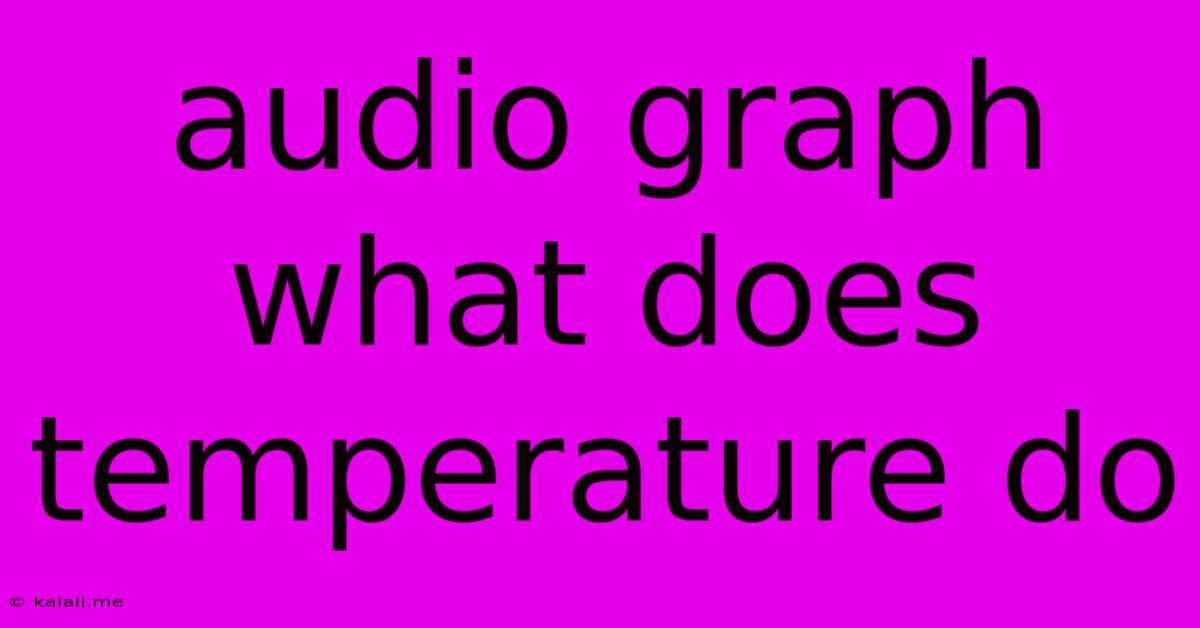Audio Graph What Does Temperature Do
Kalali
Jun 04, 2025 · 3 min read

Table of Contents
How Temperature Affects Audiographs: A Deep Dive
Meta Description: Understanding the impact of temperature on audiographs is crucial for accurate analysis. This article explores how temperature variations affect audio signals and the implications for various applications. Learn about thermal noise, component sensitivity, and best practices for maintaining optimal temperature conditions.
Temperature plays a surprisingly significant role in the accuracy and reliability of audiographs. While often overlooked, variations in temperature can introduce noise, distort signals, and impact the overall performance of audio equipment, ultimately affecting the integrity of the resulting audiograph. Understanding this relationship is crucial for achieving accurate and reliable measurements and analysis in various applications, from professional audio recording to scientific research.
Thermal Noise: The Silent Enemy of Accurate Audiographs
One of the primary ways temperature affects audiographs is through thermal noise. This is a random electrical noise generated by the thermal agitation of electrons within electronic components. As temperature increases, the kinetic energy of these electrons rises, leading to a greater level of random movement and, consequently, increased thermal noise. This manifests as a hissing or crackling sound in audio recordings and can obscure subtle details in the audio signal, reducing the clarity and precision of your audiograph. This is particularly noticeable in low-level signals where the noise floor becomes a significant factor.
Component Sensitivity: A Temperature-Dependent Factor
Different components within audio equipment exhibit varying degrees of sensitivity to temperature fluctuations. Capacitors, resistors, and transistors are particularly susceptible. Temperature changes can alter their electrical properties, leading to shifts in gain, frequency response, and overall signal integrity. These changes can manifest as distortions in the audiograph, impacting the accuracy of frequency measurements and amplitude analysis. For instance, a slight temperature increase could lead to a subtle but measurable shift in the resonant frequency of a filter, impacting the overall shape of the audiograph.
Practical Implications and Mitigation Strategies
The impact of temperature on audiographs is significant across numerous fields. In professional audio recording, temperature-induced noise can compromise the fidelity of recordings, particularly for sensitive microphones or high-gain amplification. In scientific research, temperature variations can introduce uncertainties into acoustic measurements, hindering the accuracy of experimental results. Similarly, in audio surveillance, maintaining stable temperatures is critical to preserving the integrity of audio evidence.
To mitigate the effects of temperature on audiographs, consider these strategies:
- Temperature-controlled environments: Conducting measurements in a climate-controlled room minimizes temperature fluctuations and reduces the impact of thermal noise.
- Calibration: Regularly calibrating audio equipment against known standards helps to compensate for temperature-related drifts in performance.
- Pre-amplification: Utilizing high-quality pre-amplifiers with low noise floors can help to minimize the relative impact of thermal noise.
- Signal processing: Employing digital signal processing (DSP) techniques, such as noise reduction algorithms, can help to reduce the effects of thermal noise post-recording.
- Component selection: Choosing high-quality components with low temperature coefficients can improve the stability of your audio equipment over a wider range of temperatures.
By carefully considering the impact of temperature and implementing appropriate mitigation strategies, you can significantly improve the accuracy, reliability, and overall quality of your audiographs. This leads to more robust data analysis and ultimately, more informed conclusions across various applications relying on precise audio measurements.
Latest Posts
Latest Posts
-
How Do You Wire A Ceiling Fan With A Light
Jun 06, 2025
-
Nh2 At A Ph Of 4
Jun 06, 2025
-
Can You Put An Anchor Into A Stud
Jun 06, 2025
-
Every Sequence Has A Monotone Subsequence
Jun 06, 2025
-
Bark Up The Wrong Tree Meaning
Jun 06, 2025
Related Post
Thank you for visiting our website which covers about Audio Graph What Does Temperature Do . We hope the information provided has been useful to you. Feel free to contact us if you have any questions or need further assistance. See you next time and don't miss to bookmark.